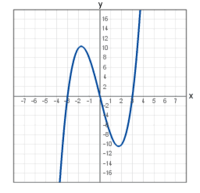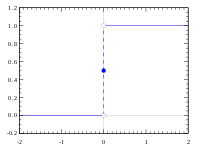बंद ग्राफ़ प्रमेय
गणित में, बंद ग्राफ़ प्रमेय कई बुनियादी परिणामों में से एक को संदर्भित कर सकता है जो किसी फ़ंक्शन के ग्राफ़ के संदर्भ में निरंतर कार्यों को चिह्नित करता है। प्रत्येक ऐसी स्थितियाँ देता है जब बंद ग्राफ़ वाले फ़ंक्शन आवश्यक रूप से निरंतर होते हैं।
बंद ग्राफ़ के साथ ग्राफ़ और मानचित्र
अगर टोपोलॉजिकल स्पेस के बीच एक मानचित्र है फिर का ग्राफ सेट है या समकक्ष,
हॉसडॉर्फ़ स्थान में किसी भी निरंतर फ़ंक्शन का एक बंद ग्राफ़ होता है।
कोई भी रेखीय मानचित्र, दो टोपोलॉजिकल वेक्टर रिक्त स्थान के बीच जिनकी टोपोलॉजी (कौची) अनुवाद अपरिवर्तनीय मेट्रिक्स के संबंध में पूर्ण है, और यदि इसके अतिरिक्त (1 ए) उत्पाद टोपोलॉजी, फिर मानचित्र के अर्थ में क्रमिक रूप से निरंतर है सतत है और इसका ग्राफ, Gr L, आवश्यक रूप से बंद है. इसके विपरीत, यदि एक ऐसा रेखीय मानचित्र है, जिसमें (1ए) के स्थान पर ग्राफ है (1बी) कार्टेशियन उत्पाद स्थान में बंद होने के लिए जाना जाता है , तब निरंतर है और इसलिए आवश्यक रूप से क्रमिक रूप से निरंतर है।[1]
सतत मानचित्रों के उदाहरण जिनमें बंद ग्राफ़ नहीं है
अगर क्या कोई स्थान है तो पहचान मानचित्र सतत है लेकिन इसका ग्राफ, जो विकर्ण है , में बंद है अगर और केवल अगर हॉसडॉर्फ है.[2] विशेष रूप से, यदि तो फिर हॉसडॉर्फ़ नहीं है निरंतर है लेकिन करता है not एक बंद ग्राफ़ है।
होने देना वास्तविक संख्याओं को निरूपित करें सामान्य यूक्लिडियन टोपोलॉजी और लेट के साथ निरूपित अविवेकी टोपोलॉजी के साथ (जहां ध्यान दें है not हॉसडॉर्फ और इसमें प्रत्येक फ़ंक्शन का महत्व है निरंतर है) होने देना द्वारा परिभाषित किया जाए और सभी के लिए . तब सतत है लेकिन इसका ग्राफ है not बंद किया .[3]
बिंदु-सेट टोपोलॉजी में बंद ग्राफ़ प्रमेय
पॉइंट-सेट टोपोलॉजी में, बंद ग्राफ़ प्रमेय निम्नलिखित बताता है:
Closed graph theorem[4] — If is a map from a topological space into a Hausdorff space then the graph of is closed if is continuous. The converse is true when is compact. (Note that compactness and Hausdorffness do not imply each other.)
First part is essentially by definition.
Second part:
For any open , we check is open. So take any , we construct some open neighborhood of , such that .
Since the graph of is closed, for every point on the "vertical line at x", with , draw an open rectangle disjoint from the graph of . These open rectangles, when projected to the y-axis, cover the y-axis except at , so add one more set .
Naively attempting to take would construct a set containing , but it is not guaranteed to be open, so we use compactness here.
Since is compact, we can take a finite open covering of as .
Now take . It is an open neighborhood of , since it is merely a finite intersection. We claim this is the open neighborhood of that we want.
Suppose not, then there is some unruly such that , then that would imply for some by open covering, but then , a contradiction since it is supposed to be disjoint from the graph of .
गैर-हॉसडॉर्फ़ स्थान कम ही देखे जाते हैं, लेकिन गैर-कॉम्पैक्ट स्थान आम हैं। गैर-कॉम्पैक्ट का एक उदाहरण वास्तविक रेखा है, जो बंद ग्राफ़ के साथ असंतत फ़ंक्शन की अनुमति देती है .
सेट-वैल्यू फ़ंक्शंस के लिए
Closed graph theorem for set-valued functions[5] — For a Hausdorff compact range space , a set-valued function has a closed graph if and only if it is upper hemicontinuous and F(x) is a closed set for all .
कार्यात्मक विश्लेषण में
अगर टोपोलॉजिकल वेक्टर स्पेस (टीवीएस) के बीच एक रैखिक ऑपरेटर है तो हम ऐसा कहते हैं यदि ग्राफ़ एक बंद रैखिक ऑपरेटर है में बंद है कब उत्पाद टोपोलॉजी से संपन्न है।
बंद ग्राफ प्रमेय कार्यात्मक विश्लेषण में एक महत्वपूर्ण परिणाम है जो गारंटी देता है कि एक बंद रैखिक ऑपरेटर कुछ शर्तों के तहत निरंतर है। मूल परिणाम को कई बार सामान्यीकृत किया गया है। बंद ग्राफ प्रमेयों का एक प्रसिद्ध संस्करण निम्नलिखित है।
Theorem[6][7] — A linear map between two F-spaces (e.g. Banach spaces) is continuous if and only if its graph is closed.
यह भी देखें
- Almost open linear map
- Barrelled space
- Closed graph
- Closed linear operator
- Discontinuous linear map
- Kakutani fixed-point theorem
- Open mapping theorem (functional analysis)
- Ursescu theorem
- Webbed space
- Zariski's main theorem
टिप्पणियाँ
संदर्भ
- ↑ Rudin 1991, p. 51-52.
- ↑ Rudin 1991, p. 50.
- ↑ Narici & Beckenstein 2011, pp. 459–483.
- ↑ Munkres 2000, pp. 163–172.
- ↑ Aliprantis, Charlambos; Kim C. Border (1999). "Chapter 17". Infinite Dimensional Analysis: A Hitchhiker's Guide (3rd ed.). Springer.
- ↑ Schaefer & Wolff 1999, p. 78.
- ↑ Trèves (2006), p. 173
ग्रन्थसूची
- Bourbaki, Nicolas (1987) [1981]. Topological Vector Spaces: Chapters 1–5. Éléments de mathématique. Translated by Eggleston, H.G.; Madan, S. Berlin New York: Springer-Verlag. ISBN 3-540-13627-4. OCLC 17499190.
- Folland, Gerald B. (1984), Real Analysis: Modern Techniques and Their Applications (1st ed.), John Wiley & Sons, ISBN 978-0-471-80958-6
- Jarchow, Hans (1981). Locally convex spaces. Stuttgart: B.G. Teubner. ISBN 978-3-519-02224-4. OCLC 8210342.
- Köthe, Gottfried (1983) [1969]. Topological Vector Spaces I. Grundlehren der mathematischen Wissenschaften. Vol. 159. Translated by Garling, D.J.H. New York: Springer Science & Business Media. ISBN 978-3-642-64988-2. MR 0248498. OCLC 840293704.
- Munkres, James R. (2000). Topology (Second ed.). Upper Saddle River, NJ: Prentice Hall, Inc. ISBN 978-0-13-181629-9. OCLC 42683260.
- Narici, Lawrence; Beckenstein, Edward (2011). Topological Vector Spaces. Pure and applied mathematics (Second ed.). Boca Raton, FL: CRC Press. ISBN 978-1584888666. OCLC 144216834.
- Rudin, Walter (1991). Functional Analysis. International Series in Pure and Applied Mathematics. Vol. 8 (Second ed.). New York, NY: McGraw-Hill Science/Engineering/Math. ISBN 978-0-07-054236-5. OCLC 21163277.
- Schaefer, Helmut H.; Wolff, Manfred P. (1999). Topological Vector Spaces. GTM. Vol. 8 (Second ed.). New York, NY: Springer New York Imprint Springer. ISBN 978-1-4612-7155-0. OCLC 840278135.
- Trèves, François (2006) [1967]. Topological Vector Spaces, Distributions and Kernels. Mineola, N.Y.: Dover Publications. ISBN 978-0-486-45352-1. OCLC 853623322.
- Wilansky, Albert (2013). Modern Methods in Topological Vector Spaces. Mineola, New York: Dover Publications, Inc. ISBN 978-0-486-49353-4. OCLC 849801114.
- Zălinescu, Constantin (30 July 2002). Convex Analysis in General Vector Spaces. River Edge, N.J. London: World Scientific Publishing. ISBN 978-981-4488-15-0. MR 1921556. OCLC 285163112 – via Internet Archive.
- "Proof of closed graph theorem". PlanetMath.
- Templates that generate short descriptions
- Collapse templates
- Navigational boxes
- Navigational boxes without horizontal lists
- Sidebars with styles needing conversion
- Templates generating microformats
- Templates that are not mobile friendly
- Wikipedia metatemplates
- कार्यात्मक विश्लेषण में प्रमेय
- Machine Translated Page
- Created On 13/10/2023

